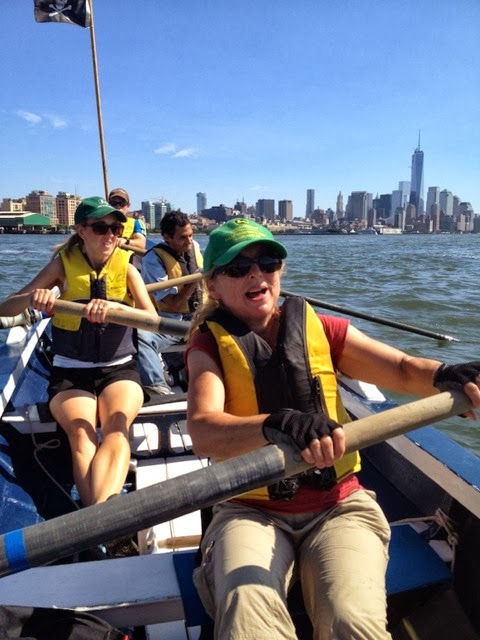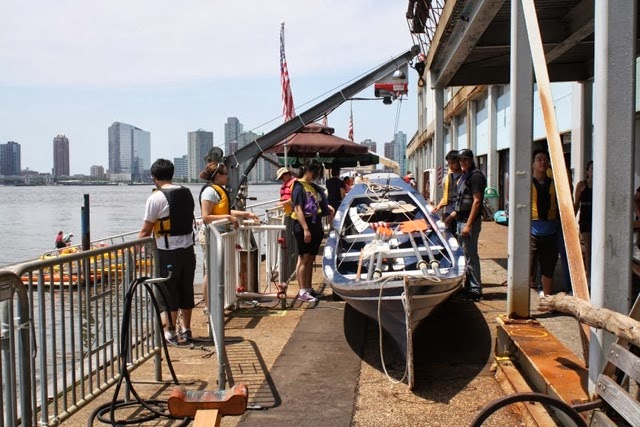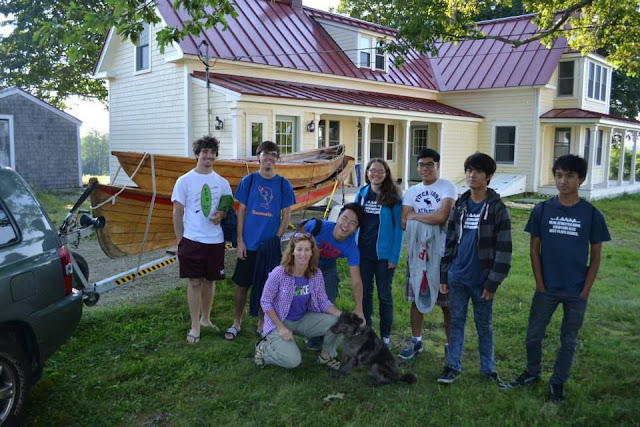Fourteen rowers from Village Community Boathouse traveled from New York City to Warren where they joined forces with Don Betts and some Warren Whirleygigs for the Fourth Annual Arrogance of Self-righteousness Row. The thirty mile row is a reenactment of a voyage by Roger Williams, founder of Rhode Island, who in 1670 at the age of 70 rowed in an open boat from Providence to Newport to engage some Quakers in a debate about religion.(See below for details.)
Two six-oared rowing gigs completed the voyage: Cady, belonging to Don Betts and Voyager, loaned by Ben Booth of Dharmavoager.org. Voyager is outfitted with sliding seats, providing a new experience for the VCB crew. Don Bett’s Cat Boat served as a chase boat.
Following a sliding seat demonstration by Ben Booth, the gigs set off from India Point down the Providence River on August 3rd with the ebb tide at about 8:30 AM. The row was uneventful and the gigs landed on Prudence Island at about 12:30 PM. They set off the next morning for Newport at about 8:00 AM and landed in Jamestown before noon. The crew spent the rest of the day exploring a group of islands called The Dumplings and a house, Clingstone built in 1905, perched atop a small dumpling, near Jamestown. Then the fleet crashed the Newport Jazz Festival and toured Newport Harbor before landing to catch the RIPTA bus to Providence for the trip back to NYC.
Rowers: Joe Fung, Brian Tong, Dexter Tong, Junze He, Kristina Pan, Eric Cerny, Anna Juchnicki, Haymar Lim, Shana Luo, Daryl Sew, Marcus Chan, Chaerin Jun, Fabian Czerwinski, Elisa Steinfurth, Linda Remington, Mary Betts, Riley
Chase Boat: Don Betts, Sally Curtis, Dave Clayton
Back Story
by Don Betts

Roger Williams (1603 -1683) was an American Protestant theologian, and the first American proponent of religious freedom and the separation of church and state. In 1636, he began the colony of Rhode Island and Providence Plantations, which provided a refuge for religious minorities. He was a student of Indian languages and an advocate for fair dealings with Native Americans. Roger Williams made himself not welcome just about everywhere he went
except among the natives but in the founding of Rhode Island the important thing to keep in mind is that he got off on arguing religion and making sure that religion was kept out of politics. Newport and Providence or Rhode Island and Providence Plantations, or the term popular in the mid 1600s was Rouges Island, were exceptions in New England in that people were not jailed or maimed or excecuted or run off for their religion or lack of it. Williams had left England because of the mixing of the royalty and the church that changed back and forth between pope and non pope ideas depending on who lost their heads.
Arriving in Boston the people there were happy at first to welcome a young recent college graduate minister. He moved on to Salem then south to Plymouth and then back to Boston and maybe Salem again. At each place they got tired of him trying to separate church and state so he left for East Providence late fall but that was still part of the Massachusetts colony so he crossed the river to Providence and spent the winter with the natives there who were more
hospitable to guests than those of European background. He wrote a book, “A Key to the Language of America” about the Indian language and culture published in London in 1643. Then about 1670 or so George Fox came to the other end of the bay, so the rowing and digging start.
George Fox (July 1624 – 13 January 1691), the founder of the Religious Society of Friends, commonly known as the Quakers. visited New England in 1672. Being more discreet than others of his sect, he went only to Rhode Island, avoiding Connecticut and Massachusetts. Roger Williams, who denied the pretensions to spiritual enlightenment, challenged Fox to disputation. Before the challenge was received, Fox had departed,but three of his disciples at Newport accepted it. Williams went there in an open boat, 30 miles from Providence, and, though over seventy years of age, rowed the vessel himself. After his 18 hour row to Newport he spent three days, Saturday Monday and Tuesday but not Sunday debating with three Quakers. Williams Wrote to George and George’s assistant or cohort Mr. Burrowes the 14 points about “Digging the Fox out of his Burrowes”. an account of the three days’ disputation, which at times was a tumultuous quarrel; to which Fox replied in a pamphlet entitled, “A New England Firebrand Quenched” and “The Arrogance of Self Rightousness”. Neither was sparing in sharp epithets..
From what I’ve read of these things the titles are the best part.




